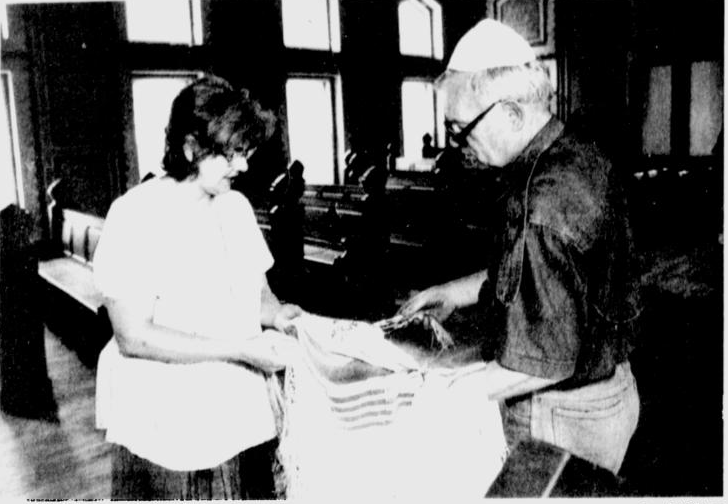Jews Fought in the Bosnian Army Side by Side with the Muslims
Institute for the Research of Genocide Canada
Published: November 19, 2010
The following article was first published on 5 September 1992 by Kentucky New Area newspapers. Posted with permission.

Zoya Finci (left) and Predrag Papo (right) inspect a prayer shawl at the Jewish Community Center in Sarajevo. The remaining 1,000 members of the Jewish community remaining in the besieged Bosnian capital now conduct prayer services at their homes after shutting down their synagogue which was shelled by Serbian artillery.
With Bosnian war raging, Jewish group celebrates life
By John Pomfret
SARAJEVO, Bosnia-Herzegovina — On a ping-pong table in a cluttered room next to a synagogue, Zoya Finci works to restore ancient parchments – Hebrew scripts telling the story of the exodus of Jews from the Holy Lands. A dab of acetone here, a swab of alcohol there.
Despite the crash of mortars and heavy machine-gun fire outside, Finci is preparing for an exhibition. With an almost heroic obstinacy, the Jews of Sarajevo are planning to celebrate their 500 years in the city.
“It only comes once every 500 years,” said the middle-age University of Sarajevo art professor, whose family has lived in Sarajevo for four centuries.
“We can’t postpone it. We have to celebrate it despite the bloodshed.“
About 1,000 Jews are left from an original population of 1,600. About 600 women, children and elderly have been evacuated since the war for control of Bosnia-Herzegovina began between the mainly Muslim government and the self-proclaimed Serbian Republic of Bosnia-Herzegovina.
Some went to Israel, others to Austria and Italy. Spain, where 95 percent of the Sephardic Jews in Sarajevo trace their roots, took 50 families.
Ivan Ceresnjes, 47, the president of the Jewish community, said only a few more Jews want to leave.
“The rest will stay in Sarajevo,” he said. “We are Bosnians first.”
Jews are fighting in the Bosnian army – side by side with Muslims. They are in the police force and work in civil defense, he said. The Jewish graveyard, with tombs dating to the 16th century, is a Serbian stronghold. Serb militiamen have placed a heavy machine-gun in its chapel.
The tribulations of Ceresnjes’ family highlights the sometimes colorful, often tragic history of the Jews in this part of the world.
Expelled from Spain during the Inquisition, the first Jews came to the hard scrabble country around Sarajevo in September 1492 — the year Christopher Columbus landed in the Americas. Records kept in the city say the first Jews arrived on Sept. 11, the date this year’s exhibition begins.
Boats from the Ottoman Empire — which saved Jews and Arabs alike from the religious suppression launched by the Roman Catholic Church in Spain — brought them to the Balkans.
In recognition, they invited Turkish President Turgut Ozal to the exhibition.
“I don’t think he’ll come,” Finci said with a sigh, as another mortar shell landed nearby.
Ceresnjes’ father, Alexander, returned to Spain during the Spanish Civil War in the 1930s to join Communist forces. In World War II, he was interned in France. He escaped, volunteering for the British 8th Army for the liberation of Italy.
There he met his wife, a psychological operations officer with the British and also a Sephardic Jew.
They married. She became pregnant. Alexander Ceresnjes went to Hungary after liberation and she returned to Sarajevo, where Ceresnjes was born.
Alexander Ceresnjes became the minister of information for the Hungarian government; in 1948, he was jailed for eight years in a Soviet prison camp for opposing the Soviet takeover in Budapest. He died later in Hungary.
“For the last 400 years, none of my family has died in Sarajevo,” Ceresnjes said. It is a classical Jewish tale. We are from this place but cannot die here.”
Jakob Finci’s family, a distant relative of Zoya’s, followed another path. for the past 500 years, all his relatives have been born or died in Sarajevo – except him.
He was born in a concentration camp run by the pro-Nazi Ustasha militia in Croatia in 1943. Now, he is a lawyer and vice president of the Jewish community’s Educational and Humanitarian Society.
Spanish traditions died hard among the Jews of Sarajevo. They pray in Castilian Spanish, greet each other with “Buenos dias” and pick Iberian names for their children, such as Estella and Juan.
For now, no synagogue remains in Sarajevo. Three rocket attacks forced the community to remove the torah and holy books from the Arc – the room where they were kept – stripping it of its religious nature.

